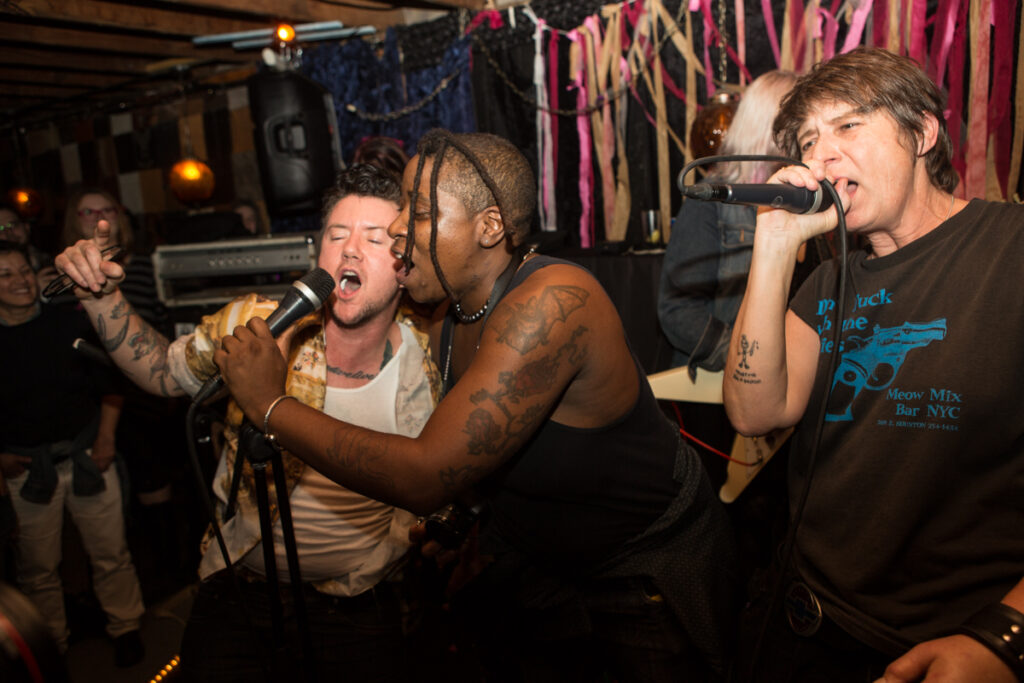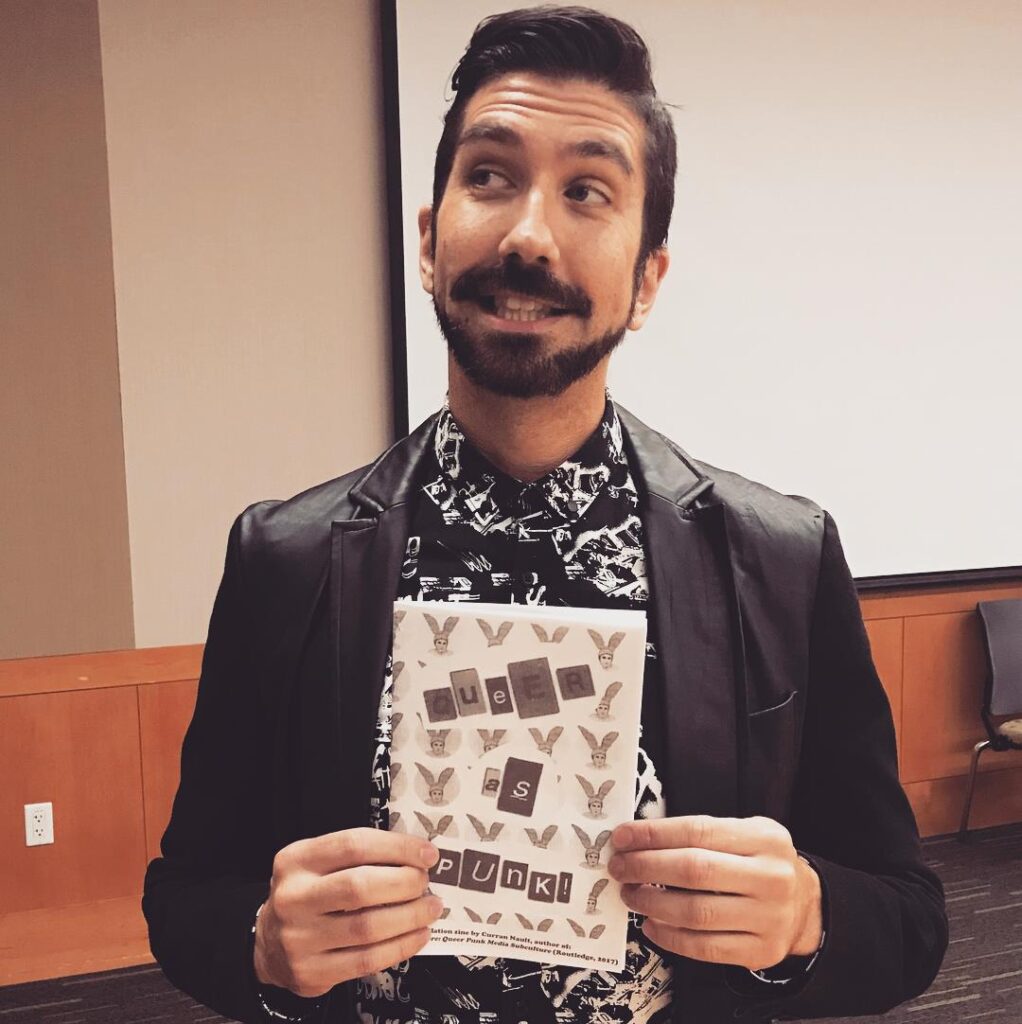by Curran Nault
Growing up a shy, effeminate fag in small town Massachusetts in the 1980s and early 90s was an education in alienation. These were the days before the Internet, before RuPaul’s Drag Race (or even Ellen), before GSAs. My only real exposure to queer-created culture came from the shelves of CDs at Tower Records, two towns over.

On-stage at the OUTsider Tribe 8 reunion. Featuring (l to r): Silas ‘Flipper’ Howard, Keiron Lynn ‘Tantrum’ and Lynnee Breedlove.
Since I lived in a place without public transportation, my trips to Tower Records were rare. But I relished them as expeditions of queer and feminist exhumation: rifling through the racks, dildo-wielding divas on the cover of God is My Co-Pilot grabbed my gaze, Bikini Kill beckoned with photos of feminist fury, and Pansy Division’s pornographic Pile-Up piqued my forming fancies. Such sexually and politically charged CDs (and many more) were purchased with purpose: they granted me an identifiable identity and a window onto an electrifyingly non-normative ecosphere.
They also gifted me a strategy for survival: being the first “out” student in my high school meant that taunts and assaults punctured my daily existence. Wearing my Walkman on the way to class, howls of “Speak Up! Don’t Put Up With It!” from Sharon Topper allowed me to channel my animosity, and to steel myself for the stretch of school ahead. Looking back, this is what my first book, Queercore, was really about: re-dressing old wounds and unpacking the essences of these queer punk works that provided me with teenage protection, while opening an exit onto an elsewhere.
Queercore: Queer Punk Media Subculture (Routledge, 2018) is a book about “coming to terms.” It concretizes the abstract vocabularies of queer theory, situating canonical queer texts alongside the queer punk films, zines, performances, music and visual art that surfaced in the same era. Queercore aligns with other academic projects that seek to steal high queer concepts back into the streets.
In the case of Queercore, into the specific streets of Queen and Parliament where queercore was initiated: that crumbling corner of Toronto on which the racoon-infested residence of G.B. Jones and Bruce LaBruce once stood. The year was 1985 and this pair of malcontent misfits was declaring “civil war” on the punk and gay and lesbian establishments, denouncing gay assimilationism and inciting punk rock rebellion inside the polemic-cum-pornographic pages of their fanzine. The zine was a tangible test case of “queer world making,” J.D.s’ salacious stories of skinhead sexcapades and cut n’paste creations of queerdo communion conjured a vibrant queer punk scene, from imagination into existence, and from Toronto into cities across North America (and beyond). Soon, bands (Fifth Column, Cholita!, Black Fag, Tribe 8, God is My Co-Pilot, Pansy Division, Huggy Bear, Team Dresch, PME, The Gossip, Le Tigre, G.L.O.S.S.…), films (No Skin Off My Ass, Sex Bomb!, Green Pubes, The Lollipop Generation, The Living End, Hedwig and the Angry Inch…), and other zines (SCAB, Bimbox, BambooGirl, Jane Gets a Divorce, Fertile La Toyah Jackson, Homocore, Outpunk, i’m so fucking beautiful, Holy Titclamps, Sister, Evolution of a Race Riot…) were calling themselves queercore too. This artistic output is the stuff of Queercore’s critical curiosity. Elsewhere, I have referred to Queercore as a missing link in history, a formative text on grassroots queer artivism, a paradigmatic political economy of DIY and deviance. It is also an archive of the overlooked.
The process of working on Queercore also unlocked my own world-making capacities. Queercore—the subcultural scene and the book project—protrudes into the present by way of OUTsider, the grassroots trans*media arts organization and festival that I founded in 2013, alongside Bobette Mathis and Annie Bush, and with the central support of Scott Dinger, Paul Soileau and PJ Raval. The idea for OUTsider was inspired by my research into popular, public queercore events, like the celebrated Spew and Homo-a-go-go. I had missed out on these occasions, so my only option to attend was to remake them for myself. As such, OUTsider is a re-generation of sorts: informed by the scrappy, anti-corporate ethics/aesthetics of punk do-it-yourself, OUTsider is a nostalgic and knowing nod to queercore.
It’s also a twist for today, platforming present tense pushbacks against new normalities (of xenophobia, neoliberalism, racism, transmisogyny, homonormativity…). Decidedly contemporary concoctions include Conference on the Couch, in which artists, academics and community members commingle in my living room, collectively producing knowledge on an intimate scale; and oppositional art that extends beyond narrow notions of “punk” (and the white, able-bodied, cis-masculinity it can connote), like the expansive performance art of such OUTsider alums as Narcissister, Zackary Drucker, La Chica Boom, Nao Bustamante, Cassils, Dorian Wood, Pêdra Costa and M. Lamar. I chose the name OUTsider to signify a queered alignment with multiple margins. OUTsider intends to bend the blueprints; to fudge the festival format; to render radical intimacies; to forefront queer of color and trans* creativities; to fold in forgotten voices and visions; and to ask of us, what mischief can we make today? This latter question is a queercore mantra of misbehavior–one that rebounds in my writings, in my sonic resistance to high school homophobia, and in my will to keep on cultivating culture and community that is queer as punk.
15 Fierce Queercore Anthems to Spark You Up:
1. Vaginal Davis, “Queens (Make the World)”
2. God is My Co-Pilot, “QDA (Queer Disco Anthem)”
3. Big Joanie, “Fall Asleep”
4. Fagatron, “Asskickatron”
5. FEA, “Mujer Moderna”
6. Huggy Bear, “Her Jazz”
7. The Younger Lovers, “We are the Younger Lovers/Keeps on Falling Down”
8. Men (featuring Anohni), “Who Am I to Feel So Free?”
9. The Gossip, “Standing in the Way of Control”
10. G.L.O.S.S., “Trans Day of Revenge”
11. Downtown Boys, “Monstro”
12. Aye Nako, “Nightcrawler”
13. Team Dresch, “Don’t Try Suicide”
14. Tribe 8, “Rise Above”
15. Le Tigre, “Keep on Livin’”

Curran Nault is an Assistant Professor in the Department of Radio-Television-Film, as well as a faculty affiliate of the Center for Women’s and Gender Studies (CWGS) and the Center for Asian American Studies (CAAS). He is also the Artistic Director and Founder of OUTsider.
